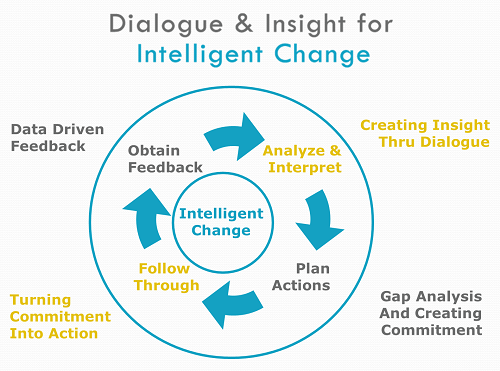When you walk in the room, who shows up for Read more →
Feedback Should be “Just Right”
Posted Friday, August 31, 2012Allen Slade
A careful reading of Goldilocks and the Three Bears suggests three lessons for leaders: Moderation in all things. Don’t be impulsive. Breaking & entering causes problems, especially at the Bears.
Previous posts have looked at The Problem with Feedback and Different Perspectives on Feedback. Today, we will consider moderation in two aspects of feedback. Instead of a single feedback cycle that may be too hot or too cold, just right feedback requires that you mix the timing of your feedback cycles. And, don’t just impulsively act on feedback. Use insight and analysis to balance openness to feedback with constancy of purpose.
Multiple Feedback Cycles
As a leader, you should be open to feedback because you need to know “When I walk in the room, who shows up for the other people?” You need to seek out feedback relentlessly. 
But it is not enough to collect feedback tidbits. To drive intelligent change, you must analyze and interpret the feedback you receive. You must plan actions based on the feedback. You must follow through with your plans. Then, you must start the cycle again by collecting more feedback. If things are going well, continue on. If your feedback suggest things are not going well, change something – your follow through, your action plan or your analysis and interpretation of the feedback. This feedback cycle drives intelligent change.
How long should your cycle take? Consider feedback cycles of three lengths:
Long-cycle feedback. This is feedback on long term impact, such as data from the annual employee opinion survey or a 360 report. Long-cycle feedback looks at the sum of your actions over a period of time. Long-cycle feedback is typically generated by the organization with safeguards to increase its validity (e.g., anonymity) and relevance to organizational leadership (e.g., a competency model). Yet long-cycle feedback by itself is not enough to develop your leadership. The assessments underlying long cycle feedback are complex and open to rating errors. And, a leader cannot afford to wait a year to find out if leadership changes are effective.
Short-cycle feedback. This is feedback on a recent event, such as post action feedback right after a meeting. Short-cycle feedback looks at your actions in the very recent past. The advantage of short-cycle feedback is that it reduces the delay in adjusting a new behavior. The disadvantages of short-cycle feedback are often a lack of anonymity and a lack of structure.
The quick check-in is a useful form of short-cycle feedback. After a conversation or meeting, ask “How did today’s conversation (or meeting) go for you?” Most of the time, the answer will be “It went well.“ or ”Great.” In that case, continue on. Sometimes, you will hear something of incredible value. “We are bogging down in the data.” “To be honest, I was bored.” “You have spinach between your teeth.” Treat this feedback as a valuable nugget. Adjust the agenda, amp up the excitement or do a quick floss job.
Instant feedback. This is feedback in the moment, such as watching non-verbal language of others in a meeting or hearing a change in voice tone during a phone call. Instant feedback allows the leader to adjust on the fly. Instant feedback requires mindfulness of the cues that others give in the moment. It also requires the ability to multi-task by talking and watching, by focusing on your message and your impact on the other party, at the same time.
You need a mixture of these cycles. Instant feedback and short-cycle feedback, in excess, may be too hot. Long-cycle feedback, by itself may be too cold. But, combined in the right proportions, these different cycles can be just right.
Balancing Openness to Feedback with Constancy of Purpose
When you receive feedback, another form of moderation is needed. You need to consider the feedback before acting. In the heat of the moment, while receiving negative feedback, you can go overboard. You can impulsively agree to do everything the feedback giver wants. This strong desire to please can backfire. If you submit totally to the other person’s judgment, you undermine the powerful dialogue that should come with feedback. And, you subordinate your purpose to their goals for you. In effect, you jump from feedback to action plan without your own careful analysis and interpretation.
It is better to balance openness to feedback with constancy of purpose. The other person’s feedback is always valid and always valuable. Yet their goals for you may not be identical to your purpose. My advice is to accept all feedback from all willing parties, without necessarily submitting to their action plans for you. The balanced reaction to feedback is to listen, to learn and to engage the other person in mutual problem solving.
Back at the Bears
Let me close with another observation: Goldilocks had no support team for her decisions. Impulse can be moderated by wise counsel. Mixing feedback cycles is more complex than simply waiting for annual leadership feedback. Balancing openness to feedback with constancy of purpose is harder than a simple rule for action. I recommend using the power of collaboration to maximize the power of feedback. Work with your circle of trusted advisors, your mentor or your leadership coach to master feedback. Gather a support team to create dialogue and insight to drive intelligent change for your leadership.
Bottom line: As a leader, actively seek feedback. Gather the right mix of long-cycle, short-cycle and instant feedback. Balance constancy of purpose with openness to feedback. Gather your support team to get your use of feedback just right.
And don’t break & enter, especially at the Bears.

